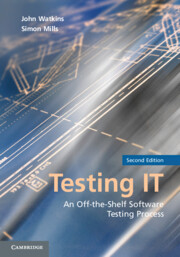Book contents
- Frontmatter
- Contents
- Foreword to the Second Edition by Geoff Thompson
- Foreword to the First Edition by Maurice Rosenburgh
- Acknowledgments
- 1 Introduction
- PART 1 THE TRADITIONAL TESTING PROCESS
- PART 2 THE TESTING PROCESS IN THE REAL WORLD: ILLUSTRATIVE CASE STUDIES
- PART 3 THE APPENDICES
- Appendix A Terms of Reference for Testing Staff
- Appendix B Testing Guides
- Appendix C Test Plan Document Template
- Appendix D Test Specification Document Template
- Appendix E Test Script Template
- Appendix F Test Result Record Form Template
- Appendix G Test Log Template
- Appendix H Test Certificate Template
- Appendix I Reuse Pack Checklist
- Appendix J Test Summary Report Template
- Appendix K Equivalence Partition Example
- Appendix L Boundary Value Analysis Example
- Appendix M State Transition Example
- Appendix N Pairwise Testing Example
- Appendix O Automated Testing Tool Selection Criteria
- Appendix P Usability Testing Overview
- Appendix Q Testing Process Health Check
- Appendix R The Testing of Object-Oriented Software
- Appendix S Pragmatic Test Process Adoption – a Real-World Example
- References
- Glossary
- Index
Appendix I - Reuse Pack Checklist
Published online by Cambridge University Press: 03 May 2011
- Frontmatter
- Contents
- Foreword to the Second Edition by Geoff Thompson
- Foreword to the First Edition by Maurice Rosenburgh
- Acknowledgments
- 1 Introduction
- PART 1 THE TRADITIONAL TESTING PROCESS
- PART 2 THE TESTING PROCESS IN THE REAL WORLD: ILLUSTRATIVE CASE STUDIES
- PART 3 THE APPENDICES
- Appendix A Terms of Reference for Testing Staff
- Appendix B Testing Guides
- Appendix C Test Plan Document Template
- Appendix D Test Specification Document Template
- Appendix E Test Script Template
- Appendix F Test Result Record Form Template
- Appendix G Test Log Template
- Appendix H Test Certificate Template
- Appendix I Reuse Pack Checklist
- Appendix J Test Summary Report Template
- Appendix K Equivalence Partition Example
- Appendix L Boundary Value Analysis Example
- Appendix M State Transition Example
- Appendix N Pairwise Testing Example
- Appendix O Automated Testing Tool Selection Criteria
- Appendix P Usability Testing Overview
- Appendix Q Testing Process Health Check
- Appendix R The Testing of Object-Oriented Software
- Appendix S Pragmatic Test Process Adoption – a Real-World Example
- References
- Glossary
- Index
Summary
Introduction
This appendix contains guidance on ensuring that the reuse of tests and testing materials is achieved between testing phases and testing projects. It includes:
How and when to create a reuse pack
A list of the typical contents of a reuse pack
Guidance on using reuse packs.
Creating a Reuse Pack
At the end of any testing phase, the test team leader (or development team leader during unit and integration testing) should collect copies of a number of items generated during the testing project into a single file (a simple A4 manila folder is usually sufficient for this purpose). This file is termed a reuse pack.
The reuse pack will be archived with the rest of the project files and can be subsequently retrieved on request from the testing manager (or equivalent role).
The contents of the reuse pack can be used by other testing projects to reduce the effort and cost associated with testing and to improve the consistency and quality of testing.
Examples of the use of reuse packs include:
During subsequent testing phases of the same application under test (AUT) (such as reusing some system tests during acceptance testing)
In regression testing modifications to the same AUT (such as either rerunning a complete system test or selected elements of the system test)
Where the AUT is similar or related to another AUT (such as employing existing integration test material when an additional module is added to an existing suite of applications).
- Type
- Chapter
- Information
- Testing ITAn Off-the-Shelf Software Testing Process, pp. 259 - 260Publisher: Cambridge University PressPrint publication year: 2010



